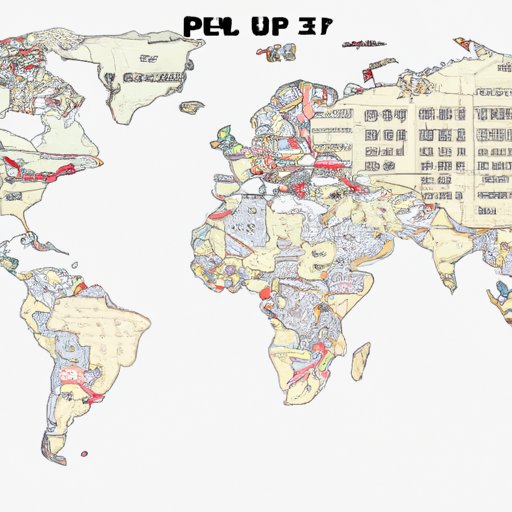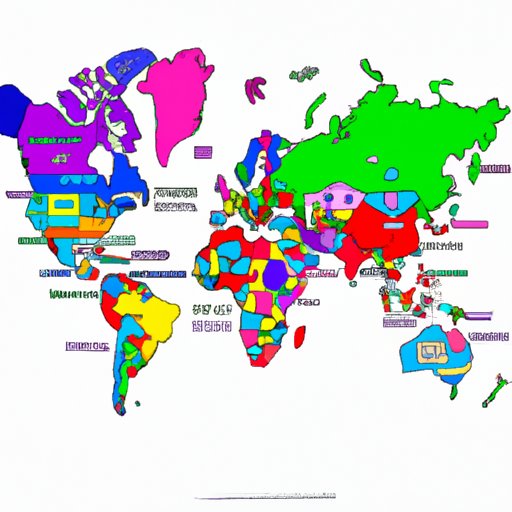Introduction
In today’s modern age, it is easy to take for granted the vastness of our planet and the incredible diversity of its people and cultures. But understanding the geopolitical landscape of our world can be a complex endeavor, as there are countless countries and territories that make up this global community. So, how many countries are there in the world? To answer this question, we must first define what constitutes a country.
A country is a sovereign state with a distinct population, territory, and government. This means that in order for a group of people to be considered a country, they must have a defined land area, a population, and a governing body. Additionally, a country must be recognized by other countries and have a seat in the United Nations. With that being said, let’s explore the geopolitical landscape of our planet.

Comprehensive List of All Countries in the World
The world is divided into six major regions: Europe, North America, South America, Africa, Asia, and Oceania. Each region is made up of multiple countries and territories, so let’s take a closer look at each region and its constituent countries.
Europe
Europe is home to over 50 countries, including some of the most powerful economies in the world. The European Union (EU) is a political and economic union of 28 member states that are located primarily in Europe. Additionally, there are several microstates and disputed territories located in Europe, such as Vatican City, Monaco, and Kosovo. The full list of countries located in Europe is as follows:
- Albania
- Andorra
- Armenia
- Austria
- Azerbaijan
- Belarus
- Belgium
- Bosnia and Herzegovina
- Bulgaria
- Croatia
- Cyprus
- Czech Republic
- Denmark
- Estonia
- Finland
- France
- Georgia
- Germany
- Greece
- Hungary
- Iceland
- Ireland
- Italy
- Kazakhstan
- Kosovo
- Latvia
- Liechtenstein
- Lithuania
- Luxembourg
- Macedonia
- Malta
- Moldova
- Monaco
- Montenegro
- Netherlands
- Norway
- Poland
- Portugal
- Romania
- Russia
- San Marino
- Serbia
- Slovakia
- Slovenia
- Spain
- Sweden
- Switzerland
- Turkey
- Ukraine
- United Kingdom
- Vatican City
North America
North America is comprised of 23 countries and numerous island territories. The largest country in the region is the United States of America, followed by Canada and Mexico. Other countries located in North America include Antigua and Barbuda, Bahamas, Belize, Costa Rica, Cuba, Dominica, Dominican Republic, El Salvador, Grenada, Guatemala, Haiti, Honduras, Jamaica, Nicaragua, Panama, St. Kitts and Nevis, St. Lucia, St. Vincent and the Grenadines, Trinidad and Tobago, and the Turks and Caicos Islands.
South America
South America is home to 12 countries and several dependent territories. The largest countries in the region are Brazil, Argentina, and Colombia. Other countries located in South America include Bolivia, Chile, Ecuador, Guyana, Paraguay, Peru, Suriname, Uruguay, and Venezuela.
Africa
Africa is home to 54 countries and numerous islands and territories. The largest countries in Africa are Nigeria and Ethiopia. Other countries located in Africa include Algeria, Angola, Benin, Botswana, Burkina Faso, Burundi, Cameroon, Cape Verde, Central African Republic, Chad, Comoros, Congo, Cote d’Ivoire, Democratic Republic of the Congo, Djibouti, Egypt, Equatorial Guinea, Eritrea, Eswatini, Gabon, Gambia, Ghana, Guinea, Guinea-Bissau, Kenya, Lesotho, Liberia, Libya, Madagascar, Malawi, Mali, Mauritania, Mauritius, Morocco, Mozambique, Namibia, Niger, Rwanda, Sao Tome and Principe, Senegal, Seychelles, Sierra Leone, Somalia, South Africa, South Sudan, Sudan, Tanzania, Togo, Tunisia, Uganda, Zambia, and Zimbabwe.
Asia
Asia is the largest and most populated continent in the world, with 48 countries and an array of island territories. The largest countries in the region are China, India, and Russia. Other countries located in Asia include Afghanistan, Armenia, Azerbaijan, Bahrain, Bangladesh, Bhutan, Brunei, Cambodia, East Timor, Georgia, Hong Kong, Indonesia, Iran, Iraq, Israel, Japan, Jordan, Kazakhstan, Kuwait, Kyrgyzstan, Laos, Lebanon, Macao, Malaysia, Maldives, Mongolia, Myanmar, Nepal, North Korea, Oman, Pakistan, Palestine, Philippines, Qatar, Saudi Arabia, Singapore, South Korea, Sri Lanka, Syria, Taiwan, Tajikistan, Thailand, Turkey, Turkmenistan, United Arab Emirates, Uzbekistan, Vietnam, and Yemen.
Oceania
Oceania is comprised of 14 countries and several island territories. The largest countries in the region are Australia and New Zealand. Other countries located in Oceania include American Samoa, Cook Islands, Fiji, French Polynesia, Guam, Kiribati, Marshall Islands, Micronesia, Nauru, New Caledonia, Niue, Northern Mariana Islands, Palau, Papua New Guinea, Samoa, Solomon Islands, Tokelau, Tonga, Tuvalu, Vanuatu, and Wallis and Futuna.

Exploring the Different Regions and Political Entities Around the Globe
Now that we have a comprehensive list of all the countries in the world, let’s take a look at some of the major regions and territories around the globe. Each region has its own unique history, culture, and politics, so exploring these different parts of the world can help us gain a better understanding of the geopolitical landscape of our planet.
Europe
Europe is one of the oldest and most culturally influential regions in the world, with a rich history stretching back thousands of years. Today, the European Union is a powerful political and economic force in the world, and it is comprised of 28 member states. The EU has its own currency, the euro, and it has implemented various policies aimed at protecting the environment, promoting human rights, and strengthening economic ties between member states.
North America
North America is home to two of the most powerful countries in the world—the United States of America and Canada. The US is the world’s largest economy, and it is a major political and military power. Canada is an important trading partner of the US, and it is known for its progressive social policies. Additionally, several Caribbean and Central American countries are located in North America, such as Cuba, Jamaica, and Mexico.
South America
South America is a diverse region with a vibrant culture and a tumultuous political history. It is home to some of the world’s largest economies, such as Brazil and Argentina, and it is a major producer of agricultural products, minerals, and energy. Additionally, South America is home to a variety of indigenous peoples, such as the Inca, the Maya, and the Quechua.
Africa
Africa is the second-largest continent in the world, and it is home to some of the world’s most diverse cultures and languages. The region has experienced tremendous change in recent decades, as many African countries have achieved independence from colonial powers and begun to develop their own economies and governments. Additionally, Africa is home to some of the world’s poorest countries, such as Somalia and the Democratic Republic of the Congo.
Asia
Asia is the largest and most populous continent in the world, and it is home to some of the world’s oldest cultures and civilizations. The region is incredibly diverse, with hundreds of different languages and cultures. It is also home to some of the world’s most powerful countries, such as China and India, and it is a major player in the global economy.
Oceania
Oceania is a relatively small region, but it is home to some of the most beautiful places on earth. It is comprised of 14 countries and several island territories, and it is known for its stunning beaches, lush rainforests, and vibrant cultures. The region is also home to some of the world’s most remote and isolated communities, such as the Pitcairn Islands and the Easter Island.
Mapping the World: A Look at the Nations and Territories of Our Planet
Now that we have explored the different regions and political entities around the globe, let’s take a look at the physical maps of each region. By examining the maps, we can get a better understanding of the geopolitical landscape of our planet and the relationships between countries and territories.
Overview of Major Regions
The following map provides an overview of the major regions of the world, including Europe, North America, South America, Africa, Asia, and Oceania.

Physical Maps of Each Region
The following maps provide a detailed look at the countries and territories of each region.
Europe

North America

South America

Africa

Asia

Oceania

Global Statistics: How Many Countries Are There in the World?
With so many countries and territories around the globe, it can be difficult to keep track of them all. So, how many countries are there in the world? According to the United Nations, there are currently 195 countries in the world. This number includes 193 member states of the United Nations, as well as two non-member observer states—the Holy See (Vatican City) and the State of Palestine. Additionally, there are numerous disputed territories and autonomous regions that are not officially recognized as countries.
It is important to note that the number of countries in the world has changed throughout history. For example, the breakup of the Soviet Union in 1991 resulted in the creation of 15 new countries, and the reunification of East and West Germany in 1990 resulted in the formation of a single German nation. Additionally, the dissolution of Czechoslovakia in 1993 resulted in the formation of two separate countries—the Czech Republic and Slovakia.
Conclusion
In conclusion, the world is comprised of 195 countries, as well as numerous disputed territories and autonomous regions. Each region has its own unique history, culture, and politics, and exploring these different parts of the world can help us gain a better understanding of the geopolitical landscape of our planet. Additionally, the number of countries in the world has changed throughout history, as new countries have been created and existing countries have been dissolved or combined.
Understanding the geopolitical landscape of our planet is an important part of being an informed global citizen. By taking the time to learn about the different countries, territories, and regions of the world, we can gain a greater appreciation for the diversity of our planet and the people who inhabit it.


